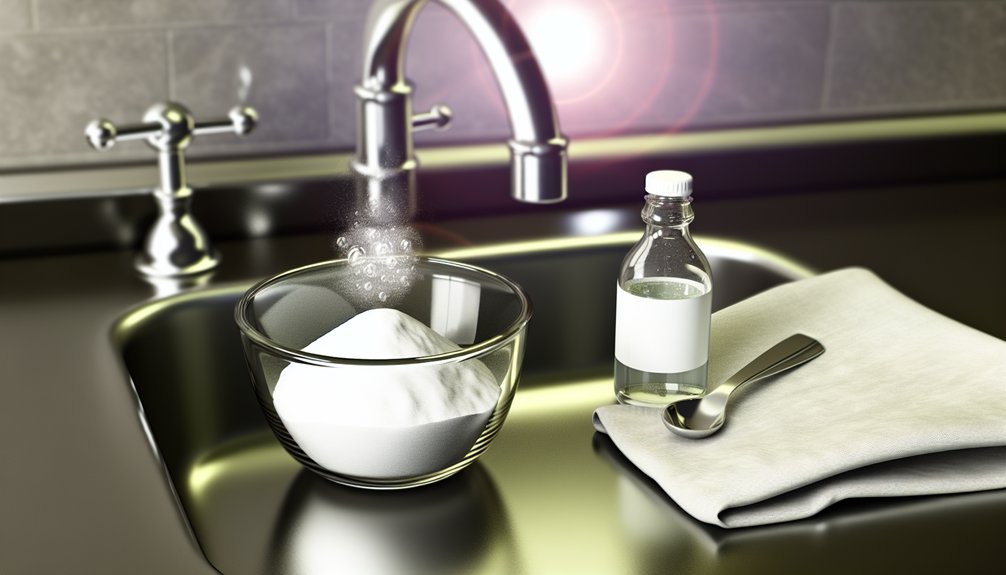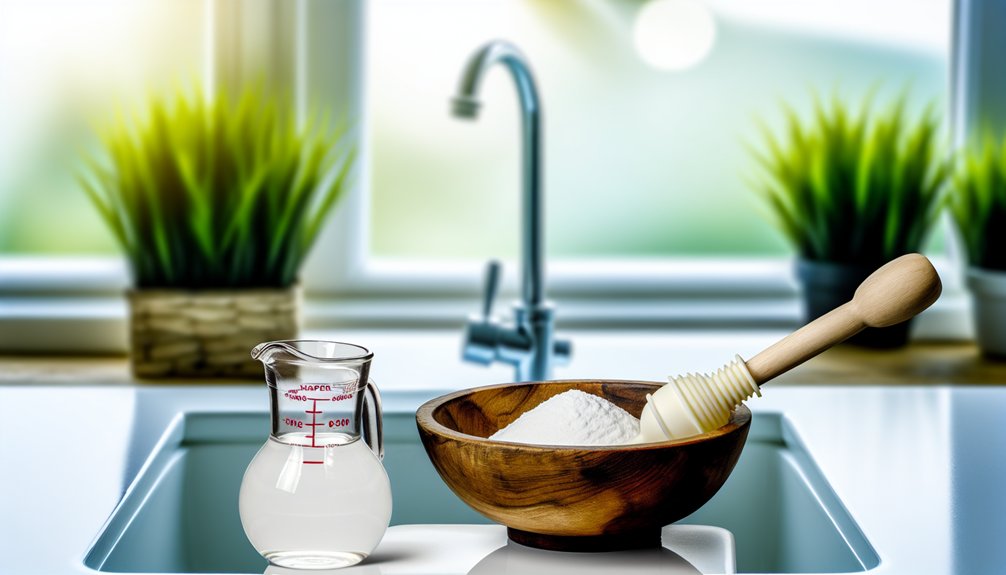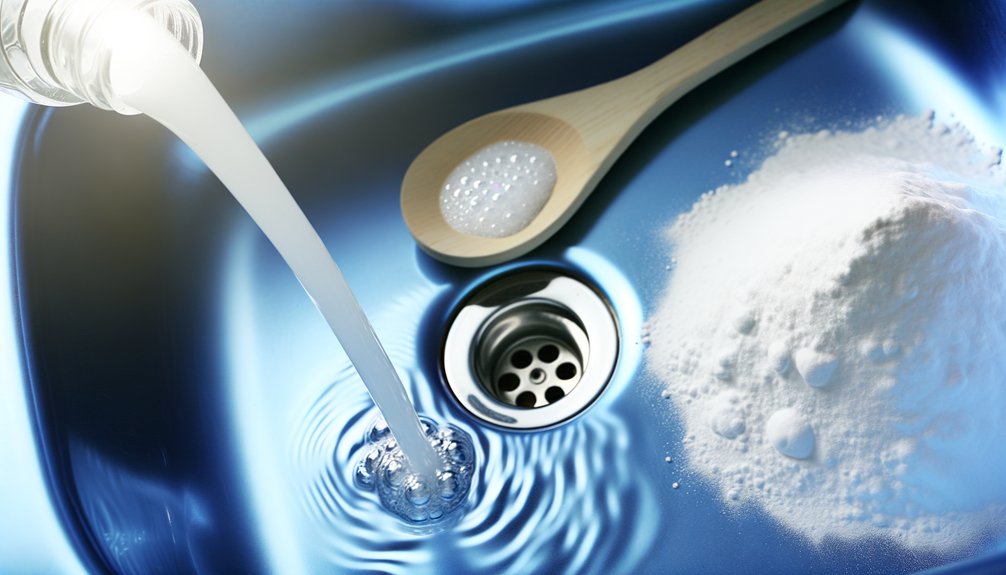The baking soda and vinegar method is a popular, eco-friendly solution for unclogging drains. To utilize this technique, one should first remove standing water, then pour 1/2 cup of baking soda followed by 1/2 cup of vinegar into the drain. Cover the drain to contain the fizzing reaction for at least 30 minutes. Finally, flush the drain with boiling water. This process not only clears clogs but also helps maintain long-term cleanliness. More effective tips await.
Understanding the Baking Soda and Vinegar Method

The baking soda and vinegar method is a popular and effective technique for addressing clogged drains. This maintenance method harnesses a chemical reaction between baking soda and vinegar, which produces carbon dioxide gas. When one cup of baking soda is followed by one cup of vinegar, a fizzing action occurs that targets organic clogs such as hair and grease. The reaction generates heat and pressure, effectively loosening stubborn blockages without the need for harsh chemicals. This approach is particularly effective on softer clogs, making it an ideal choice for routine cleaning drains. After allowing the reaction to take place, flushing the drain with hot water helps clear any remaining residue. Regular use of this method not only unclogs drains but also promotes long-term cleanliness, empowering individuals to maintain their plumbing systems with ease and confidence.
Step-by-Step Process for Unclogging Drains
To effectively unclog drains using the baking soda and vinegar method, one must follow a straightforward process that maximizes the cleaning potential of these household ingredients.
- Remove any standing water in the sink to enhance the effectiveness of the solution.
- Pour directly 1/2 cup of baking soda into the clogged drain, followed by 1/2 cup of vinegar. Cover the drain with a cloth and let it sit for at least 30 minutes to contain the fizzing reaction.
- Afterward, flush with two cups of boiling water to wash away loosened debris.
For tougher clogs, allowing the mixture to sit overnight can yield better results. Regular maintenance using this method every few months helps prevent buildup, ensuring a clear drainage system and addressing minor clogs efficiently. This DIY drain solution empowers individuals to tackle clogs with confidence and ease.
Preventative Measures for Future Clogs

After addressing current clogs with effective solutions, attention turns to preventative measures that can help avoid future issues. Regularly flushing drains with boiling water and dish soap, at least once a week, can effectively dissolve grease and prevent buildup. Installing drain strainers is another vital preventative measure; these devices catch food particles, hair, and debris, ensuring they are emptied frequently to maintain ideal flow. It is important to avoid pouring grease, oil, or coffee grounds down the drain, as these can solidify and create clogs. Scheduling routine cleaning with a baking soda and vinegar mixture every one to three months keeps drains fresh and clear. Additionally, educating household members about proper disposal methods encourages them to throw solid waste in the trash rather than down the sink. Implementing these practices can greatly reduce the likelihood of clogged drains and promote a healthy plumbing system.
Frequently Asked Questions
How Do You Clean Clogs With Baking Soda?
To clean clogs with baking soda, one can utilize eco-friendly remedies that promote drain maintenance. By combining baking soda with vinegar, a natural alternative, a fizzing reaction occurs, aiding in clog prevention. This homemade solution not only dislodges debris but also offers significant baking soda benefits. For ideal results, regular application of these kitchen tips can enhance plumbing hacks, ensuring drains remain clear and fresh with minimal use of household products.
What Do You Mix With Baking Soda to Unclog a Drain?
In a surprising twist, many households discover that a simple mixture of baking soda and vinegar serves as an effective drain cleaning solution. The typical baking soda ratios involve equal parts, usually 1/2 cup of each. This eco-friendly solution not only aids in clog prevention but also acts as a homemade cleaner, offering a safe alternative to harsh chemicals. Adhering to plumbing tips and safety precautions guarantees efficient drain maintenance and ideal results.
Does Vinegar and Baking Soda Really Unclog Drains?
The effectiveness of vinegar and baking soda for unclogging drains is often debated. Many consider it a valuable addition to drain maintenance tips, as it serves as a natural cleaning solution and an eco-friendly alternative. While this method can tackle minor clogs, plumbing myths debunked reveal it may not address tougher blockages. As a chemical-free unclogging option, it offers sustainable home practices, making it a practical choice for kitchen drain care and bathroom maintenance ideas.
Does Baking Soda and Vinegar Dissolve Hair Clogs?
Baking soda and vinegar serve as effective hair clog solutions, leveraging their chemical reactions to offer eco-friendly unclogging. The fizzing action created by this combination aids in dislodging hair, a common clog cause. While baking soda benefits plumbing maintenance by preventing future blockages, vinegar's effectiveness enhances the overall cleaning process. These natural drain cleaners are practical DIY drain remedies, making them ideal household cleaning hacks for maintaining clear drains and managing hair removal methods.



